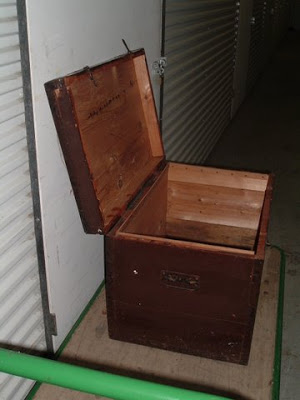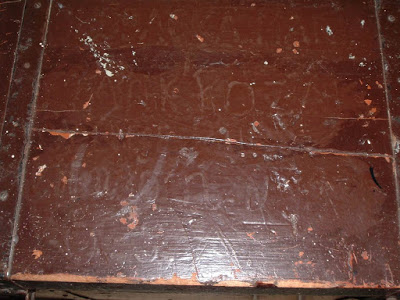Wooden Trunk from Buchenwald
John Guzlowski
The piece appeared in John Guzlowski's book about his parents and their experiences in the war and as refugees in America. The book is titled "Echoes of Tattered Tongues: Memory Unfolded."
When my parents, my sister Donna, and I finally left the refugee camp in Germany after World War II, we were allowed to bring very little, only what would fit into a steamer trunk. The problem was that we couldn't afford to buy one. Not many of the refugee families living in the camps could. You can imagine why that was, so my father did what other people did. He and a friend got together and built a trunk.

Photos: Christiana Conway
Someplace, somehow, they found a hammer and a saw, nails and some metal stripping, and they set to work. Getting the wood wasn’t a problem. They got the wood from the walls of the barracks we were living in. It was one of the old German concentration camps barracks that had been converted to living space for the refugees, the Displaced Persons, and this place didn’t have finished walls of plaster, or anything like that. If you wanted a board, you could just pull it off of the wall, and that’s what my father did.
I don’t think he felt guilty about busting up those walls. He had been a prisoner in Buchenwald Concentration Camp for almost five years, and he spent enough time staring at them, so he probably felt he could do anything he wanted to them, and it would be okay. I think if a man spends enough time staring at a thing, finally it becomes his by a kind of default. I don’t know if that’s what my dad thought. He didn’t say a lot about building that wooden trunk, and he probably didn’t give it much thought.
The trunk my father and his friend built out of those old boards wasn't big. It was maybe four feet wide and three feet tall and three feet deep. The walls of the trunk were about 3/4 of an inch thick. But wood is always heavy, so that even though it wasn’t that big, that trunk generally needed two people to lift it. My father, of course, could lift it by himself. He was a small man, a little more than five feet tall, but he had managed to survive four years in Buchenwald as a slave laborer. That work taught him to do just about any work a man could ask him to do. My father could dig for beets in frozen mud and drag fallen trees without bread or hope.
My parents couldn't get much into the trunk, but they put into it what they thought they would need in America and what they didn't want to leave in Germany: some letters from Poland, four pillows made of goose feathers, a wooden cross, a black skillet, some photographs of their time in Germany, some clothing, of course, and wool sweaters that my mother knitted for us in case it was cold in America. Somewhere, I’ve got a picture of me wearing one of those sweaters. It looks pretty good. My mother knitted it before her eyes went bad, and she was able to put little reindeer and stars all over that sweater.
When we finally got to America, my parents didn't trash that wooden trunk or break it up, even though there were times when breaking it up and using the wood for a fire would have been a good idea, kept us warm. Instead, they kept it handy for every move they made during the next forty years. They carried it with them when we had to go to the migrant farmers' camp in upstate New York to work off the cost of our passage to America. And my parents carried it to Chicago when they heard from their friend Wenglaz that Chicago was a good place for DPs, for refugees. And they carried that trunk to all the rooming houses and apartment buildings and houses that we lived in Chicago, in the area that was then known as the Polish Triangle. I remember in those early days in Chicago there were times when the only things we owned were the things my mother and father brought with us in that trunk, and the only furniture we had was that trunk. Sometimes it was a table, and sometimes it was a bench, and sometimes it was even a bed for my sister and me.
When we were kids growing up, my sister Donna and I played with the trunk. It had large blocky letters printed on it, the names of the DP camp we came from in Germany, the port we sailed from, and the port we sailed to in America. We would trace the letters with our fingers even before we could read what they said. We imagined that trunk was the boat that brought us to America, and we imagined that it was an airplane and a house. We even imagined that it was a swimming pool, although this got harder to imagine as we got older and bigger.
When my parents retired in 1990 and moved from Chicago to Sun City, Arizona, they carried that trunk with them. That surprised me because they didn’t take much with them when they went to Arizona. They sold or gave away almost everything they owned, almost everything they had accumulated in thirty-eight years of living in America. They got rid of bedroom suites and dining room suites, refrigerators and washing machines, ladders and lawnmowers. My parents were never sentimental, and they didn’t put much stock in stuff. They figured it would be easier to buy new tables and couches when they got to Sun City.
But they kept that trunk and the things they could put in it.

Photos: Christiana Conway
And a TV set.
After my father died in 1997, my mother stayed on in Arizona. She still had the trunk when she died. She kept it in a small, 8 foot x 8 foot utility room off the carport. My parents had tried to pretty it up at some point during their time in Arizona. The original trunk was bare, unpainted wood, and was covered with those big, blocky, white letters I mentioned. But for some reason, my parents had painted the wooden trunk, painted it a sort of shiny dark brown, almost a maroon color; and they had papered the bare wood on the inside of the trunk with wallpaper, a light beige color with little blue flowers.
When my mom died, I was with her. Her dying was long and hard. She had had a stroke and couldn't talk or understand what was said. She couldn't move at all either. When she finally died, I had to make sense of her things. I contacted a real estate agent, and he told me how I could get in touch with a company that would sell off all of my mother's things in an estate sale.
I thought about taking the wooden trunk back home with me to my home in Valdosta, Georgia. I thought about all it meant to my parents and to me, how long it had been with them. How they had carried it with them from the DP camps in Germany to Sun City, Arizona, a desert place so different from anything they had ever known overseas. I knew my sister Donna didn't want the trunk. I called her up, and we talked about the things my mother left behind and the estate sale and the trunk. Donna had spent a lifetime trying to forget the time in the DP camps and what the years in the slave labor camps during the war had cost my parents.
But did I want it?
I contacted UPS about shipping it, what it would cost, how I would have to prepare the trunk. They told me it would cost about $150 to ship.
But did I want it?
I finally decided to leave it there in Sun City and to let it get sold off at the estate sale. That wooden trunk had been painted over, and the person buying it wouldn't know anything about what it was and how it got there. It would just be an anonymous, rough-made trunk, painted a dark brown, almost maroon color with some goofy wallpaper inside.
Thinking back on all of this now, I'm not sure I know why I left that trunk there. When I'm doing a poetry reading and tell people the story of the trunk and read one of my poems about it, people ask me why I left it. It doesn't make any kind of sense to them. And I'm not sure now that it makes any kind of sense to me either.
So why did I leave it?
I was pretty much used up by my mom's dying. It had been hard. My mother went into the hospital for a gall bladder operation and had had that stroke, and the stroke left her paralyzed, confused, and weak. She couldn’t talk or move, and the doctor told me that my mother couldn’t even understand what was being said to her.
Her condition got worse pretty fast, and I put her in a hospice in Sun City. I sat with her there for three weeks, watched her breathing get more and more still. Sometimes, her eyes would open, and she would look around. I would talk to her then about things I remembered, her life and my father’s life, my life and my sister’s life. I don’t know if she understood anything. She couldn’t blink or nod, or make sounds with her mouth. I just talked to her about what I remembered, any stupid thing, the bus rides we took, the TV shows she always watched, the oleanders she and my dad liked to grow and plant in the backyard. I didn't think that there was much else I could do for her.
When she died, I didn't want to do anything except get back home to my wife Linda in Georgia. Maybe the extra burden of figuring out how to carry that trunk back to Georgia was more than I could deal with. Or maybe I thought that trunk wasn't the same trunk that my parents had brought from the concentration camp in Germany. It had been painted, changed.
Or maybe I just wanted that trunk to slip away into memory the way my mother had slipped away, become a part of my memory, always there but not there.